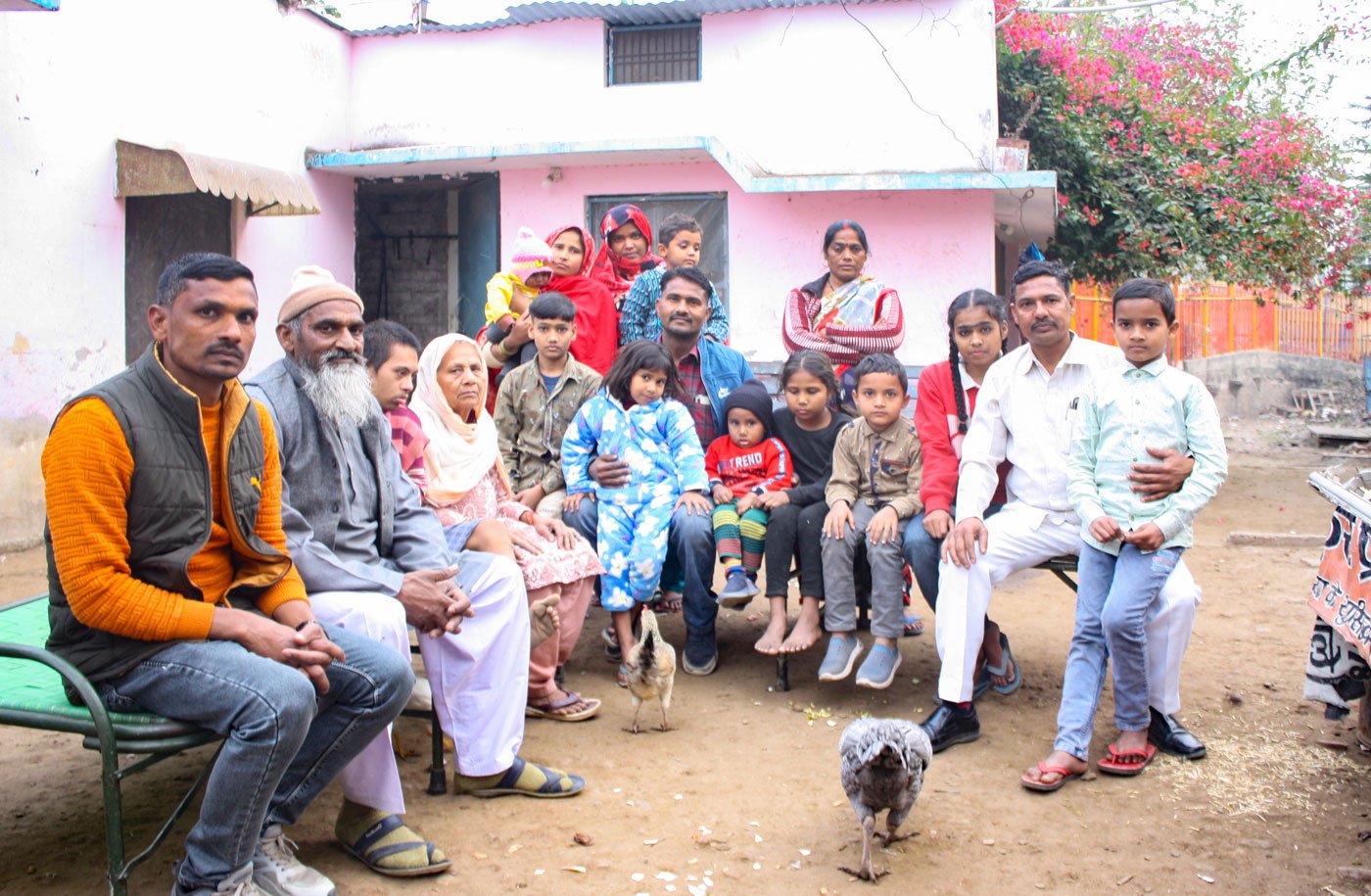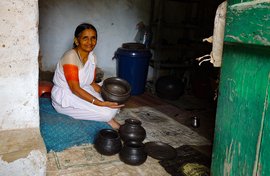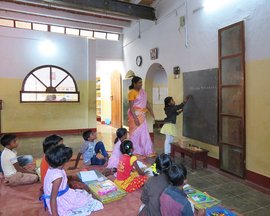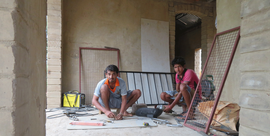“ Yeh batana mushkil hoga ki kaun Hindu hai aur kaun Musalman [It is hard to point out who is a Hindu and who is a Muslim].”
Mohammad Shabbir Qureshi, 68, is speaking about himself and his neighbour, Ajay Saini, 52. The two are residents of Ayodhya, and have been friends for the last 40 years in the Durahi Kuan neighbourhood of Ramkot.
The families are close, share daily concerns and rely on each other. Ajay Saini recalls, “one time while I was away at work, I got a call from home that my daughter was sick. In the time I could rush back home, my wife informed that the Qureshi family took our daughter to the hospital, and also bought the medicines.”
The backyard where the duo is seated is crowded with buffaloes, goats and half a dozen chickens. Children of both their families are running around, playing and chatting.
It’s January 2024 and the Ram temple in Ayodhya is getting ready for a high-profile inauguration. A new, heavy, double-barricaded iron grill fence separates their houses from the compound of the temple.
Saini was a young teenager when he and his family moved into the house next to Qureshi in the eighties. He would sell flower garlands for a rupee to devotees visiting the Ram idol in the premises of what was then the Babri Masjid.
The Qureshis were
originally butchers, the family owned a meat shop on the outskirts of Ayodhya
town. Post 1992, after their house was destroyed in arson, the family started a
welding business.


Left: Ajay Saini (on a chair in green jacket), and his wife, Gudiya Saini chatting around a bonfire in December. They share a common courtyard with the Qureshi family. Also in the picture are Jamal, Abdul Wahid and Shabbir Qureshi, with the Saini’s younger daughter, Sonali (in a red sweater). Right: Qureshi and his wife along with his grandchildren and Saini’s children
“Look at these children…they are Hindus…we are Muslims. They are all brothers and sisters,” Qureshi says, pointing at a crowd of neighbourhood children of all ages who are playing around them. “ Ab aap hamare rehen sahen se pata kijiye ki yaha kaun kya hai. Hum ek doosre ke saath bhedbhaav nahi karte [From our everyday living you cannot tell who belongs to which religion. We don’t discriminate between us],” he adds. Gudiya Saini, Ajay Saini’s wife agrees and adds: “it does not make any difference to us that they are of different religion.”
When Qureshi’s only daughter Noorjehan was getting married a decade ago, Ajay Saini says, “we were involved in the festivities, welcoming and serving guests. We get the same amount of respect as a family person. We know we are there for each other.”
Soon the conversation shifts to the Ram temple which they can see from where they sit. It’s imposing structure, still under construction, rises into the sky, flanked by massive cranes, all of it covered in a winter haze.
Qureshi points towards the imposing structure of the new temple, barely a few feet from his modest brick and mortar house. “ Woh masjid thi, wahan jab maghrib ke waqt azan hoti thi toh mere ghar mein chirag jalta tha ” [There was a mosque there, and at the call of the azaan we would light the evening lamp in my house],” he says reminiscing of a time before the mosque was brought down.
But in early January 2024, it is not only the silence of the azaan that is worrying Qureshi.
“We have been informed there are plans to clear all of these houses adjoining the Ram temple compound. In the months of April-May [2023], district authorities from the land revenue department visited the area and took measurements of the houses,” Saini told this reporter. Since Saini and Qureshi’s house abuts the temple compound and the double barricaded fence.
Gudiya adds, “ we are happy that such a big temple has come up near our house and all this development taking place around. But these things [displacement] are not going to help us,” she says. ” Ayodhya ka kayapalat ho raha hai, par hum hi logo ko palat ke [they are transforming Ayodhya by turning us away].”
A short distance away, Gyanmati Yadav has
already lost her home and the family is now housed under a temporary thatched
hut, covered in cow dung and dry hay. “We never imagined that we will have to
give up our house so that Ram can get his temple,” says the widow who is trying
to hold her family together in their new surroundings. The Yadavs earn their
living by selling milk.


Gyanmati (left) in the courtyard of her house which lies in the vicinity of the Ram temple, and with her family (right). Son Rajan (in a blue t-shirt) is sitting on a chair
Her pucca house of six rooms adjoined the temple’s front entrance in the Ahirana mohalla, but was demolished in December 2023. “They just brought the bulldozer and demolished our house. When we tried to show them the documents, house tax and electricity bills, the officers said it is of no use,” her elder son Rajan said. That night, the family of four children, an elderly father-in-law and six cattle were left shivering in the winter cold without a roof. “We were not allowed to take anything,” he adds. The family has already moved twice before setting up in the tarpaulin tent.
“This was my husband’s family house. He and his siblings were born here more than five decades ago. But we didn't receive any compensation as authorities said this was nazul land [government land], even when we had the documents to prove our ownership,” says Gyanmati.
Qureshi and his sons say if provided adequate compensation they will find another piece of land within Ayodhya city’s limits, but it won’t be a happy move. “Everyone knows us here; we have close relations. If we move out of here and locate to [Muslim-dominated] Faizabad,” says Jamal Qureshi, one of Shabbir’s younger sons, “then we will be like other common people. We won’t be Ayodhyawasi [residents of Ayodhya].”
A feeling shared by Ajay Saini who says, “our faith is attached to this land. If we are dispatched far, some 15 kms away, then you will take away both our faith and our business.”
Saini’s reluctance to leave his house and move far away is also tied to his work. “I cycle daily for 20 minutes from here to sell flowers at the Nageshwarnath temple near Naya Ghat. I earn between 50 to 500 rupees daily based on the tourist crowd. This is my only source of income to run the family. Any change will mean “longer travel time and additional expenditure,” he adds.
Jamal says, “We are proud that such a magnificent temple is standing in our backyard. It has been approved on the basis of faith by the country’s highest court, and there are no reasons to oppose it.”
“But,” he adds, “we won’t be allowed to live
here. We are getting evicted.”


Left: Workmen for the temple passing through Durahi Kuan neighbourhood in front of the double-barricaded fence. Right: Devotees lining up at the main entrance to the Ram temple site
The families are already feeling the pressure of living in the militarised zone with armed Central Reserve Police Force (CRPF) men milling around, and a watchtower standing guard in the temple’s rear compound, close to their house. “Every month, different agencies come here four times for verification checks of residents. If we have guests and relatives staying overnight, then it is mandatory to furnish their details to the police,” says Gudiya.
Locals are barred from riding on Ahirana galli and certain roads near the temple. Instead they must take a long winding route to reach the central location of Hanuman Garhi.
For the grand inauguration of the Ram temple
held on January 22, 2024, the road in front of their homes in Durahi Kuan was
the route for VIPs like political leaders, ministers and celebrities who came
in droves.
*****
On Monday, February 5, 2024, the state government unveiled its budget for 2024-25 and dedicated it to lord Ram. “Lord Shri Ram is in the thought, pledge and in every word of the Budget," Chief Minister, Yogi Adityanath said. The budget has allocated more than Rs. 1,500 crore for infrastructural development in Ayodhya including Rs. 150 crore for tourism development and Rs. 10 crore for the International Ramayana and Vedic Research Institute.
The temple complex is said to spread over 70 acres of land. The main Ram mandir covers 2.7 acres. The entire project draws funds from the Shri Ram Janmabhoomi Teerth Kshetra Trust (SRJTKT). This trust is among the favoured few organisations to be registered under the Foreign Contribution Regulation Act (FCRA) which allows donations from foreign nationals; donations made to the trust by Indian nationals are eligible for tax deductions.
Union government largesse can be seen in the flood of funds to develop Ayodhya – Rs.
11,100 crore
worth of ‘development’ projects along with
Rs. 240 crore
to revamp the railway station and Rs.1,450 crore for a new airport.
After the
inauguration, more upheavals are expected. “Ayodhya will
experience an estimated daily footfall of over 3
lakh tourists after the opening of the temple,” says Mukesh Meshram. He is
the Principal Secretary (Tourism) of the Uttar Pradesh government.
Preparation for additional visitors
will include city-wide infrastructure expansion projects that cut right through
old homes and friendships.


Left: The Qureshi and Saini families gathered together: Anmol (on the extreme right), Sonali (in a red jumper), Abdul (in white), Gudiya (in a polka dot sari) and others. Right: Gyanmati's sister-in-law Chanda. Behind her, is the portrait of Ram hung prominently in front of the house


Left: Structures that were demolished to widen the main road, 'Ram Path'. Right: the renovated Ayodhya railway station. This week, the state budget announced more than Rs. 1,500 crore for infrastructural development in Ayodhya including Rs. 150 crore for tourism development and Rs. 10 crore for the International Ramayana and Vedic Research Institute
“The Muslim family living at the corner of the lane, who are our relatives, have already been paid compensation. Their house is partially demolished as it touches the temple fence,” adds Jamal, Qureshi’s son. He points to around 200 families, including 50 Muslim families, who live in the proximity temple’s 70-acre precinct, and who are now on the verge of eviction as the temple trust (SRJTKT) plans to acquire the properties.
“Those houses which were in the way of the temple’s perimeter have been purchased by the trust and the people have been paid due compensation. There is no plan for additional acquisition,” Sharad Sharma, VHP leader said. But locals say the trust is forcefully acquiring land in the vicinity of the temple including residential houses and religious places like Fakire Ram mandir and Badr mosque.
Meanwhile the already displaced Yadavs have hung
a photo of lord Ram at the entrance. “If we don’t display the poster, they will
make it difficult for us to even live here,” says Rajan. The 21-year-old left
his wrestling training midway to support the family who were being harassed
after they lost their home. “Every week, officials and unknown men come here
threatening to make us vacate the plot where we have built the hut. We own this
land but are not allowed to make any
pucca
construction,” he told PARI.
*****
“My house was burning. It was being looted. We were surrounded by the [angry mob],” recalls Qureshi, referring to the events on and after December 6, 1992 when the Babri masjid was brought down by Hindu mobs and Muslims were targeted in Ayodhya.
Thirty years later he says, “under such circumstances, people from my locality hid me and kept me safe. I can never forget it till I die, honestly.”
The Qureshi family are among the handful of Muslims living in the Hindu-dominated area of Durahi Kuan. “We never thought of leaving. This is my ancestral house. I do not know how many of our descendants have lived here. I am a native resident like the Hindus here,” Qureshi tells this reporter, sitting on a metal cot in his backyard. He is the head of a large family including his two brothers and their family as well his own eight sons, their wives and children. He says 18 members of his family who had stayed back, were hidden by their neighbours.
Gudiya Saini says, “they are like our family and have stood by us in happiness and sorrow. If being a Hindu you won’t help us at the time of crisis, then what should one do with such Hinduness?”
Qureshi adds: “this is Ayodhya, you cannot
understand the Hindu here, nor the Muslim. You cannot understand how deeply the people mingled with each other”


Left: 'They are like our family and have stood by us in happiness and sorrow,' says Gudiya Saini. Right: Shabbir’s grandchildren with Saini’s child, Anmol. ' From our everyday living you cannot tell who belongs to which religion. We don’t discriminate between us,' says Shabbir


Left: Shabbir Qureshi with sons Abdul Wahid and Jamal inside the family’s New Style Engineering Works welding shop. The family started with the work of making metal cots and has now progressed to erecting watch towers and metal barricades inside the Ram Janmabhoomi temple. Right: Saini’s shop on the left, and on the extreme right is Qureshi shop
After their home was burnt down, the family remade parts of the house on a narrow strip of land. The house has three different structures surrounding the open backyard to house the 60 family members.
Qureshi’s two sons – Abdul Wahid, 45, the second eldest, and Jamal, 35, the fourth – run a welding business and have had a ring-side view of the new temple’s construction. “We have worked inside for 15 years, carrying out several welding works including setting up 13 security towers and 23 barriers around the perimeter,” says Jamal. They say they work with the RSS, the VHP and all the Hindu temples, and are setting up a watch tower inside the RSS building. “ Yahi toh Ayodhya hai [this is what Ayodhya is]! Hindus and Muslims live and work with each other in peace,” says Jamal.
Their shop, New Style Engineering, operates from the front portion of their house. The irony that it is the followers of these right-wing organisations that targeted Muslims like them is not entirely lost on the Qureshi family. “Trouble starts only when outsiders come and rake up controversies,” Jamal points out.
The families are familiar with the dangers of communal tensions, especially in an election year. “We have seen these dangerous situations many times. We know it is done for political gains. These games are played for a kursi [political seat] in Delhi and Lucknow. It cannot change our bonds,” Qureshi says firmly.
Saini knows his Hindu identity can protect him temporarily in front of a violent mob, like it did in December 1992, when his house was spared and Qureshi’s attacked. “If there is fire in their house then the flames will spread to my house too,” points out Saini. In such a case, “We will put four buckets of extra water and douse the flames. We know we are there for each other,” he said, reiterating about their attachment with the Qureshi family.
“We live with each other with lot of love and affection,” adds Gudiya.



